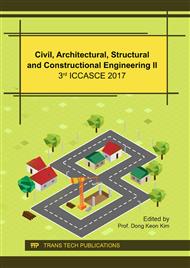[1]
J. T. Yau, L. H. Shiao, Industry analysis and management strategy for green building materials, J. Arch. 66 (2008) 35-46.
Google Scholar
[2]
H. Xu, J. S. J. van Deventer, The geopolymerisation of alumino-silicate minerals, Int. J. Miner. Proc. 59 (2000) 247-266.
DOI: 10.1016/s0301-7516(99)00074-5
Google Scholar
[3]
S. Martin, J. D. M. Kenneth, Microstructure of sodium polysialatesiloxo geopolymer, Ceram. Int. 31 (2005) 433-437.
Google Scholar
[4]
T. W. Cheng, J. P. Chiu, Fire-resistant geopolymer produced by granulated blast furnace slag, Miner. Eng. 16 (2003) 205-210.
DOI: 10.1016/s0892-6875(03)00008-6
Google Scholar
[5]
A. Fernández-Jiménez, A. Palomo, C. López-Hombrados, Engineering properties of alkali-activated fly ash concrete, J. ACI Mater. 103 (2006) 106-112.
Google Scholar
[6]
J. Davidovits, Geopolymer chemistry and applications, fourth ed., Chemical properties of condensed geopolymers, Published by: Institut Géopolymère, Saint-Quentin, France, 2008, pp.384-385.
Google Scholar
[7]
ASTM, Standard test method for time of setting of concrete mixtures by penetration resistance, C403. In: Annual Book of ASTM Standards; 04(02) (2016).
Google Scholar
[8]
ACI, Controlled low-strength materials (CLSM): reported by ACI Committee 229R, (2005).
DOI: 10.2172/505263
Google Scholar
[9]
I. Lecomte, C. Henrist, M. Liégeois, F. Maseri, A. Rulmont, R. Cloots, Micro-structural comparison between geopolymers, alkali-activated slag cement and Portland cement, J. Eur. Ceram. Soc. 26 (2006) 3789-3797.
DOI: 10.1016/j.jeurceramsoc.2005.12.021
Google Scholar
[10]
K. L. Li, G. H. Huang, J. Chen, D. Wang, X. S. Tang, Early mechanical property and durability of geopolymer, Geopolymer: Green chemistry and sustainable development solutions, In: Proceedings of the Geopolymer 2005 World Congress, 2005, pp.117-120.
Google Scholar
[11]
Y. J. Zhang, Y. L. Zhao, H. H. Li, D. L. Xu, Structure characterization of hydration products generated by alkaline activation of granulated blast furnace slag, J. Sci. Mater. 43 (2008) 7141-7147.
DOI: 10.1007/s10853-008-3028-9
Google Scholar
[12]
R. M. Ramirez, O. Ceron, N. Cabirol, F. Espejel, A. Duran, Valorization of drinking water treatment sludges as raw materials to produce concrete and mortar, Am. J. Sci. Environ. 4 (2008) 223-228.
DOI: 10.3844/ajessp.2008.223.228
Google Scholar
[13]
M. Komljenović, Z. Baščarević, V. Bradić, Mechanical and microstructural properties of alkali-activated fly ash geopolymers, J. Hazard. Mater. 181 (2010) 35-42.
DOI: 10.1016/j.jhazmat.2010.04.064
Google Scholar
[14]
Y. M. Liew, H. Kamarudin, A. M. Mustafa Al Bakri, M. Binhussain, M. Luqman, I. Khairul Nizar, C. M. Ruzaidi, C. Y. Heah, Influence of solids-to-liquid and activator ratios on calcined kaolin cement powder, Phys. Procedia 22 (2011) 312-317.
DOI: 10.1016/j.phpro.2011.11.049
Google Scholar
[15]
S. J. Lyu, T. T. Wang, T. W. Cheng, T. H. Ueng, Factors influencing mechanical properties of geopolymer: revealed by design of experiments, Taiwan Mining 64 (2012) 37-48.
Google Scholar
[16]
P. Nath, P. K. Sarker, Effect of GGBFS on setting, workability and early strength properties of fly ash geopolymer concrete cured in ambient condition, Constr. Build. Mater. 66 (2014) 163-171.
DOI: 10.1016/j.conbuildmat.2014.05.080
Google Scholar
[17]
ASTM, Standard test method for ball drop on controlled low strength material (CLSM) to determine suitability for load application, D6024. In: Annual book of ASTM standards; 04(09) (2016).
DOI: 10.1520/d6024-96
Google Scholar
[18]
ASTM. Standard test method for flow consistency of controlled low strength material (CLSM), D6103. In: Annual book of ASTM standards; 04(09) (2004).
Google Scholar
[19]
ASTM, Standard test method for density (unit weight), yield, cement content, and air content (gravimetric) of controlled low-strength material (CLSM), D6023, In: Annual book of ASTM standards; 04(09) (2016).
DOI: 10.1520/d6023-07
Google Scholar


